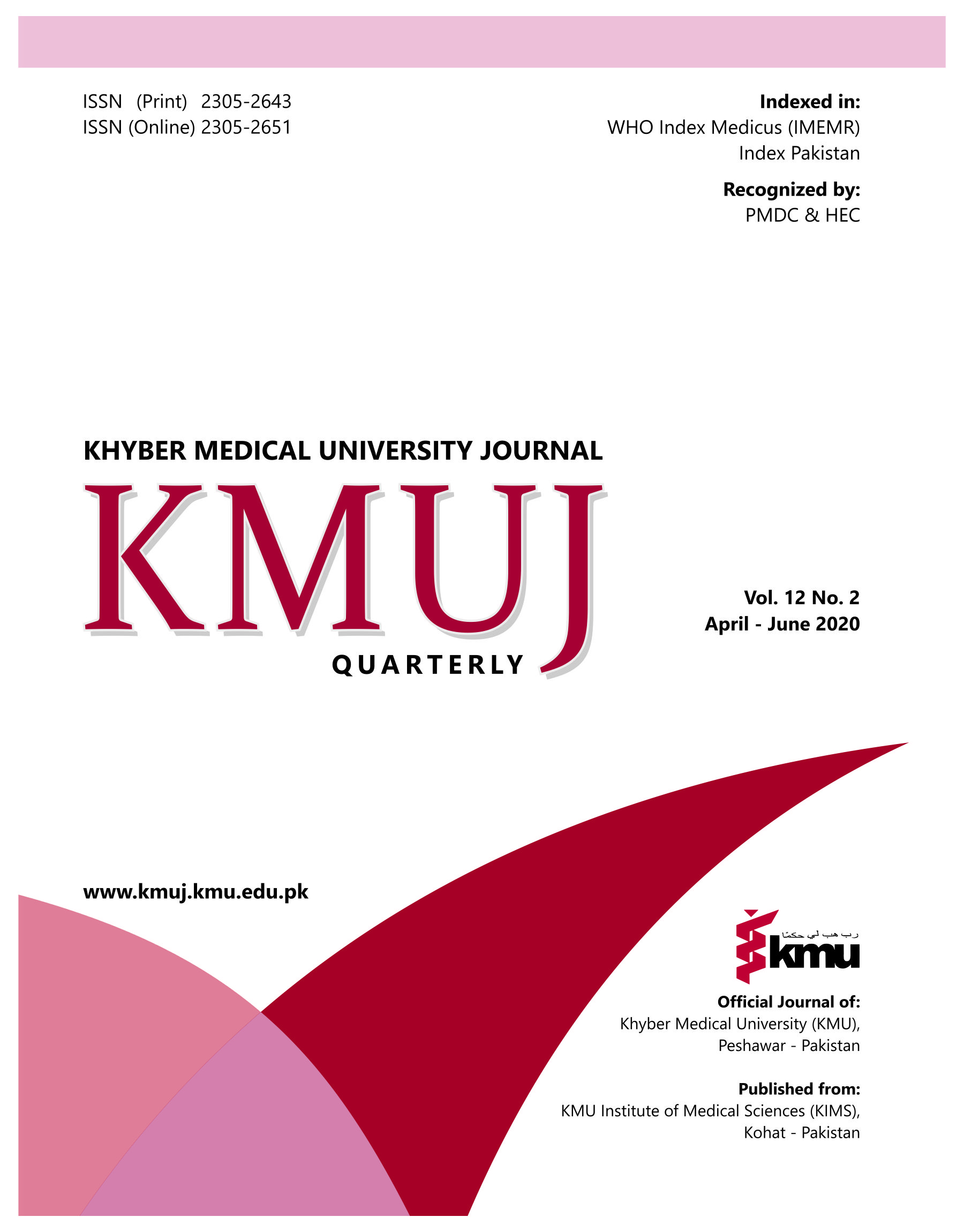SECOND MESIOBUCCAL CANALS IN MAXILLARY FIRST MOLARS DETECTED USING CONE-BEAM COMPUTED TOMOGRAPHY
Main Article Content
Abstract
OBJECTIVE: To determine the numbers of second mesiobuccal canals of first permanent maxillary molars by Cone-Beam Computed Tomography (CBCT).
METHODS: In this cross-sectional study, data of patients requiring CBCT images as part of their dental procedures were retrieved from the database of the radiology department of Sardar Begum Dental College, Peshawar, Pakistan. CBCT images of 100 maxillary 1st molars from 2016 to 2018 were selected by using consecutive sampling technique. Selection criteria for teeth were no prior endodontic treatment and roots formation completed, while teeth with open root apices and pathology were excluded. All teeth were analyzed in three planes (sagittal, axial, and coronal) and canal numbers per root were recorded. Descriptive statistics were computed in SPSS 20.0. Stratification was done for canals number in maxillary 1st molar among genders and age groups. Post, stratification Chi-Square test was applied to see effect modification.
RESULTS: The mean age of patients was 27.41±13.22 years. Second mesiobuccal canal (MB2) was present in 56 (56%) cases. Frequency of second mesiobuccal canal was more in female patients (n=29/40; 72.5%) than male patients (n=27/60; 45%) [p=0.007]. Overall, the most common age group was 10-25 years (57%) followed by 26-50 years (34%). Frequency of second mesiobuccal canal was 45.6% (n=26/57), 38.2% (n=13/34) & 33.3% (n=3/9) in age groups 10-25 years, 26-50 years & >50 years, respectively (p=.004).
CONCLUSION: A high frequency was recorded for second mesiobuccal canal in upper first molars and a significant association was noted for second mesiobuccal canal with gender and age group.
Article Details
Work published in KMUJ is licensed under a
Creative Commons Attribution 4.0 License
Authors are permitted and encouraged to post their work online (e.g., in institutional repositories or on their website) prior to and during the submission process, as it can lead to productive exchanges, as well as earlier and greater citation of published work.
(e.g., in institutional repositories or on their website) prior to and during the submission process, as it can lead to productive exchanges, as well as earlier and greater citation of published work.
References
Vertucci FJ. Root canal morphology and its relationship to endodontic procedures. Endod Topic 2005;10(1):3-29. DOI: 10.1111/j.1601-1546.2005.00129.x.
Hiebert BM, Abramovitch K, Rice D, Torabinejad M. Prevalence of second mesiobuccal canals in maxillary first molars detected using cone-beam computed tomography, direct occlusal access, and coronal plane grinding. J Endod 2017;43(10):1711-5. DOI: 10.1016/j.joen.2017.05.011.
Žemaitienė M, Grigalauskienė R, Vasiliauskienė I, Saldūnaitė K, Razmienė J, Slabšinskienė E. Prevalence and severity of dental caries among 18-year-old Lithuanian adolescents. Med 2016;52(1):54-60. DOI: 10.1016/j.medici.2016.01.006.
Carr A, Brown D. McCracken’s removable partial denture. 13th ed. Mosby, Norway: Elseviere;2011. [Accessed on: March 10, 2019]. Available from URL: https://www.elsevier.com/books/mccrackens-removable-partial-prosthodontics/carr/978-0-323-33990-2.
Wolcott J, Ishley D, Kennedy W, Johnson S, Minnich S, Meyers J. A 5 yr clinical investigation of second mesiobuccal canals in endodontically treated and retreated maxillary molars. J Endod 2005;31(4):262-4. DOI: 10.1097/01.don.0000140581.38492.8b.
Hameed MH, Khan FR. Diagnosis of second mesiobuccal canal in maxillary first molars among patients visiting a tertiary care hospital. Int J Biomed Sci 2015;11(2):107-8.
Medhat F. The prevalence of a second mesiobuccal canal of maxillary first and second molars using CBCT among egyptian population: a cross sectional study [Protocol submitted]. Cairo: Misr International University;2017. [Accessed on: March 10, 2019]. Available from URL: https://clinicaltrials.gov/ProvidedDocs/73/NCT03225573/Prot_000.pdf.
Silva EJNL, Nejaim Y, Silva AI, Haiter-Neto F, Zaia AA, Cohenca N. Evaluation of root canal configuration of maxillary molars in a Brazilian population using cone-beam computed tomographic imaging: an in vivo study. J Endod 2014;40(2):173-6. DOI: 10.1016/j.joen.2013.10.002.
Hartwell G, Bellizzi R. Clinical investigation of in vivo endodontically treated mandibular and maxillary molars. J Endod 1982;8(12):555-7. DOI: 10.1016/S0099-2399(82)80016-2.
Hasan M, Khan FR. Determination of frequency of the second mesiobuccal canal in the permanent maxillary first molar teeth with magnification loupes (×3.5). Int J Biomed Sci 2014;10(3):201-7.
Durack C, Patel S. Cone beam computed tomography in endodontics. Braz Dent J 2012;23(3):179-91.
Karabucak B, Bunes A, Chehoud C, Kohli MR, Setzer F. Prevalence of apical periodontitis in endodontically treated premolars and molars with untreated canal: a cone-beam computed tomography study. J Endod 2016;42(4):538-41. DOI: 10.1016/j.joen.2015.12.026.
Agwan AS, Sheikh Z, Dh D, Rashid H. Canal configuration and the prevalence of second mesiobuccal canal in maxillary first molar of a Saudi sub-population. J Pak Dent Assoc 2015;24(04):182-9.
Alfouzan K, Alfadley A, Alkadi L, Alhezam A, Jamleh A. Detecting the second mesiobuccal canal in maxillary molars in a Saudi Arabian Population: a micro-ct study. Scanning 2019;2019(1):1-6. DOI: 10.1155/2019/9568307.
Goldman M, Pearson AH, Darzenta N. Endodontic success—who's reading the radiograph? Oral Surg Oral Med Oral Pathol 1972;33(3):432-7. DOI: 10.1016/0030-4220(72)90473-2.
Parker JM, Mol A, Rivera EM, Tawil PZ. Cone-beam computed tomography uses in clinical endodontics: observer variability in detecting periapical lesions. J Endod 2017;43(2):184-7. DOI: 10.1016/j.joen.2016.10.007
Rodríguez G, Abella F, Durán-Sindreu F, Patel S, Roig M. Influence of cone-beam computed tomography in clinical decision making among specialists. J Endod 2017;43(2):194-9. DOI: 10.1016/j.joen.2016.10.012.
